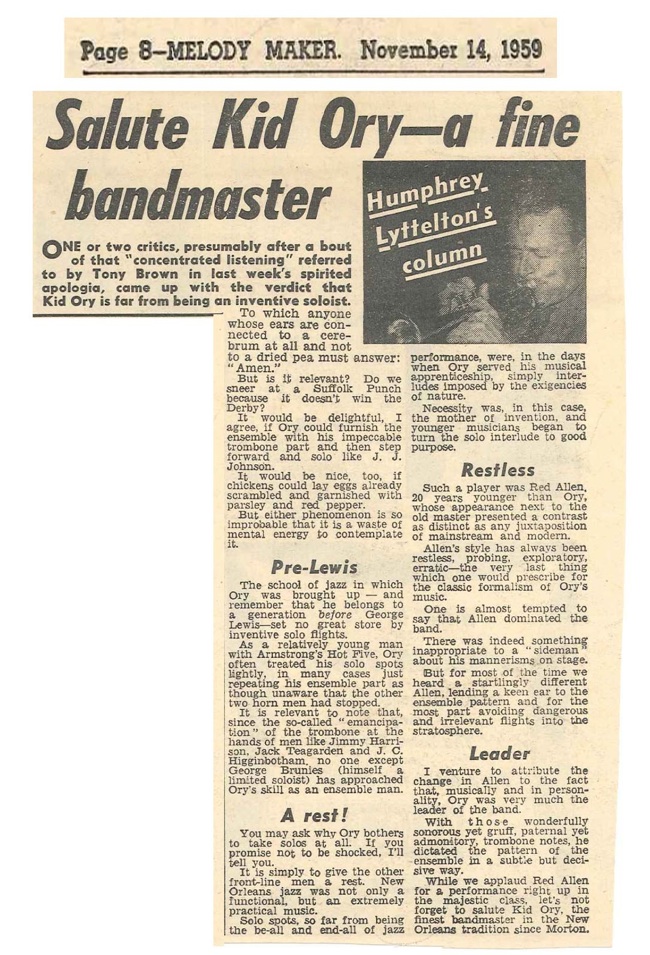1959 ENGLISH TOUR - PART 5



THE TRIBUNE – 23 OCTOBER 1959
JAZZ The old school
by EDWARD SCOBIE
DURING the last 10 years many of the giants of jazz have died ; some, prematurely, like Charlie Parker, Lester Young and Billie Holiday. Others, near their three score and ten like drummer Baby Dodds and Sidney Bechet.
But, there are still some with us. Pioneers, who were part of the growth of early jazz in its rowdy cradle—New Orleans— are very much alive at past three-score-and-ten.
One such giant is 73-year-old trombonist, Edward " Kid " Ory, - who is at the moment thrilling British Jazz audiences with the same brand of jazz he played in New Orleans over half a century ago. This is Ory's first British tour and it is being sponsored by Harold Davison.
Ory's tour will take him to Brighton, Manchester, Liverpool, Glasgow, Bradford, Bristol and finally, London, again, for his last two concerts ona October 31 and November 1. Among those with him in his Creole Jazz Band is the legendary Henry " Red " Allen on trumpet.
Edward " Kid " Ory was born in La Place, Louisiana, not far from New Orleans. In fact, as a little boy he made himself a cigar-box banjo and began strumming away. During a visit to New Orleans when he was 14, Ory had saved enough money to buy a trombone—the instrument which was to make him famous.
When the immortal trumpeter, Buddy Bolden, heard the youngster blowing the trombone he was so impressed that he offered him a job in his band straight away. Ory, because of his age, couldn't accept until the following year. When he did, he had to wear a heavy overcoat to look older because minors were not allowed in the New Orleans quarter, Vieux Carre, By the time he was 20 he had his own band—the most popular group in the city. Famous New Orleans trumpeter, Freddie Keppard, played with him. In fact, by 1910, most of the great names in jazz were playing in his band — names like Joe "King" Oliver, Johnny Dodds, Jimmy Noone and Louis Armstrong: Ory tells the story of how Armstrong came to be taken in his band: " Young Louis had just come ont of the orphanage and used to hang around while my band was playing in the parks. He always had his trumpet handy, waiting for a chance to sit in when we played a blues number. You see, Louis could play little else in those days. When Oliver left, I took him on but ordered him to buy his first pair of long trousers." When Storyville in New Orleans was closed by the United States Navy in 1917 and jazz and jazzmen moved to Chicago, Ory preferred to head for California. And, when two years tater New Orleans jazz became tremendously popular in California, he sent for some of his old musicians.
Like Buddy Bolden, King Oliver and Freddie Keppard, Kid Ory was one of the pioneers of Negro jazz. In 1921 he made the first records of Negro jazz.
One of the numbers he recorded was his own composition " Ory's Creole Trombone." In 1923, his band became the first among the Negro groups to go on the air.
Without the shadow of a ti doubt, Kid Ory reached the height of his fame as a jazz musician between the years 1925 and 1928 when he became a featured soloist with the Savannah Syncopators which was sometimes called the Dixie Syncopators. His superb solo work with Louis Armstrong and the Hot Five plus his sessions with Jelly Roll Morton and the Red Hot Peppers brought him world fame.
When the depression hit America and interest in jazz declined, Kid Ory disappeared to obscurity, keeping chickens and sorting letters in a local post office in Los Angeles.
But the New Orleans Revival in San Francisco, sparked off by Lu Wafters and his Yerba. Buena Jazz Band during the last years of World War Two, brought traditionalists like Kid Ory back to the forefront. And he hasn't looked back since. At 73 he Is still there pitchin' and blowin'.



